|

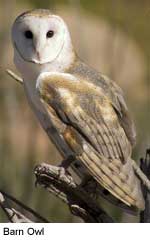 Owl's A-head: Owls have large forward-facing eyes and ears, a hawk-like beak, and usually a conspicuous circle of feathers around each eye called a facial disc. Owl's A-head: Owls have large forward-facing eyes and ears, a hawk-like beak, and usually a conspicuous circle of feathers around each eye called a facial disc.
Weights and Measures: The smallest owls include the pygmy owls, some of which are only 13 cm (5.1 in) long, have a 32 cm (12.6-in) wingspan, and weigh only 50 g (1.76 oz). The largest owls are the eagle owls, the
Eurasian Eagle Owl Bubo bubo and Verreaux's Eagle Owl B. lacteus, which may reach 76.2 cm (30 in) long, have a wingspan of just over 2 m (6.6 ft), and weigh about 4 kg (almost 9 lb).

Senses: Owls have excellent hearing and exceptional vision in low light. Compared to humans, owls have a much sharper depth of perception to their hearing. This is possible because owl ears are not placed in the same position on either side of their head: the right ear is typically set higher in the skull and at a slightly different angle. By tilting or turning its head until the sound is the same in each ear, an owl can pinpoint both the direction and the distance to the source of a sound.
Eyes: Although owls have binocular vision, their large eyes are fixed in their sockets, as with other birds, and they must turn their entire head to change views.
Vision: Owls are far-sighted, and are unable to clearly see anything within a few inches of their eyes. Their far vision, particularly in low light, is incredibly good, and they can turn their head 180 degrees around.
Hunting: Many owls can also hunt by sound in total darkness. Different species of owls make different sounds. The facial disc helps to funnel the sound of prey to their ears. In some species, these are placed asymmetrically, for better directional location.
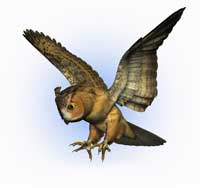 Claws and beak: Owls' powerful clawed feet and sharp beak enable them to tear their prey to pieces before eating, although most items are swallowed whole. Their muffled wings and dull feathers allow them to fly practically silent and unseen. Some fish-eating owls, which have no need of silence, lack this adaptation. Claws and beak: Owls' powerful clawed feet and sharp beak enable them to tear their prey to pieces before eating, although most items are swallowed whole. Their muffled wings and dull feathers allow them to fly practically silent and unseen. Some fish-eating owls, which have no need of silence, lack this adaptation.
Diet: Scientists studying the diets of owls are helped by their habit of disgorging the indigestible parts of their prey (bones, scales, fur, etc.) in the form of pellets. These "owl pellets" are often sold by companies to schools to be dissected by students as a lesson in biology and ecology, because they are plentiful and easy to interpret.
Eggs: Owl eggs are white and almost spherical, and range in number from a few to a dozen dependent on species. Their nests are crudely built and may be in trees, underground burrows or barns and caves.
Hunting time: Most owls are nocturnal, but several, including the pygmy owls (Glaucidium), are crepuscular, or twilight active, hunting mainly at dawn and dusk. A few owls, such as the Burrowing Owl (Speotyto cunicularia) and the Short-eared Owl (Asio flammeus), are also active during the day.
-----------------------------------------------------------------------------------------------------------------------------
Great Horned Owl
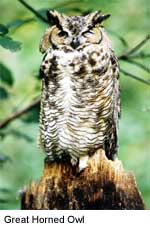 Features: The Great Horned Owl, Bubo virginianus, is a very large owl.Adults have large ear tufts, a reddish face, a white patch on the throat and yellow eyes. The ear tufts are not actually ears, but just tufts of feathers. The underparts are light with brown barring; the upper parts are mottled brown. Features: The Great Horned Owl, Bubo virginianus, is a very large owl.Adults have large ear tufts, a reddish face, a white patch on the throat and yellow eyes. The ear tufts are not actually ears, but just tufts of feathers. The underparts are light with brown barring; the upper parts are mottled brown.
The legs and feet are covered in feathers up to the talons. There are individual and regional variations in colour; birds farther north are paler.
Habitat: Their breeding habitat is almost anywhere across North America and parts of South America. They are often found in urban and suburban settings and are a common backyard bird. They often take over a nest used by some other large bird, sometimes adding feathers to line the nest but usually not much more. In the Sonoran desert, they often take over abandoned Red-tailed Hawk nests in the arms of Saguaro cacti.
Breeding time: Great Horned Owls are one of the earliest breeding owls of North America. They breed in late January or early February and are often heard calling to each other in the fall. They choose a mate by December and are often heard dueting before this time. They are permanent residents, but may wander after the nesting season.
Hunting: These birds hunt at night by waiting on a high perch and swooping down on prey. They mainly eat mammals such as rats, mice, rabbits and skunks, as well as small birds, including smaller owls. In northern regions, they may let uneaten food freeze and then thaw it out later using their own body heat.
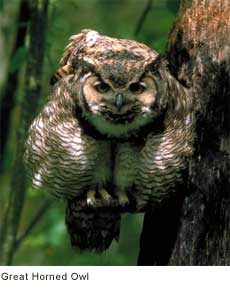
Call: Their call is a low-pitched but loud "ho-ho-hoo hoo hoo." Sometimes it is only four syllables instead of five.
The female's call is higher and rises in pitch at the end of the call. Young
owls make hissing or screeching sounds
that are often confused with the calls of
Barn Owls.
The Great Horned Owl is the provincial bird of Alberta. Great horned owls can be easily confused with Bubo magellanicus, the Magellanic Horned Owls, and species of eagle owl.
-----------------------------------------------------------------------------------------------------------------------------
Burrowing Owl
Species: The Burrowing Owl, Athene cunicularia, is a small, long-legged owl found throughout open landscapes of North and South America. There are two subspecies in North America: A. c. hypugea of southern Canada, western USA, and Mexico; and A. c. floridana of Florida and some Caribbean islands. Other subspecies are recognized in Central and South America.
Habitat: Burrowing owls can be found in grasslands, rangelands, agricultural
areas, deserts, or any other dry, open area with low vegetation. Unlike most owls, burrowing owls are often active during the day. However, most hunting is done at night.
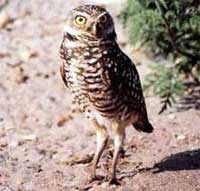 Migration: They are year-round residents in the southern areas of their range. Birds that breed in Canada and northern USA usually migrate south to Mexico and southern USA during winter months. Migration: They are year-round residents in the southern areas of their range. Birds that breed in Canada and northern USA usually migrate south to Mexico and southern USA during winter months.
Description: Adults have brown plumage with white spotting. The belly is white with brown bars. Their eyes and bill are yellow and they have long legs. The females are darker than the males. The average adult is slightly larger than a robin, at 25 cm (10 inches) length, 53 cm (21 inches) wingspan, 170g (6 oz) weight. The young owls look similar to the adults except that they have a buff bar across their wings and their chests are covered in a white to buff down.
Endangered status: The burrowing owl is endangered in Canada, threatened in Mexico, and a species of special concern in most of the western USA. The major reasons for declining populations are control programs for prairie dogs and loss of habitat. On the IUCN Red List, however, it is a species of Least Concern because of a large global population.
Life span: Burrowing owls are able to live for at least 9 years in the wild and over 10 years in captivity. They are often killed by vehicles when crossing roads, and have many natural enemies, including badgers, coyotes, and snakes. They are also killed by feral and domestic cats and dogs.
All text is available under the terms
of the GNU Free Documentation License
|